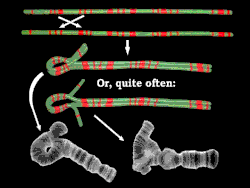Chromosomal inversion


An inversion is a chromosome rearrangement in which a segment of a chromosome is reversed end to end. An inversion occurs when a single chromosome undergoes breakage and rearrangement within itself. Inversions are of two types: paracentric and pericentric.
Paracentric inversions do not include the centromere and both breaks occur in one arm of the chromosome. Pericentric inversions include the centromere and there is a break point in each arm.
Cytogenetic techniques may be able to detect inversions, or inversions may be inferred from genetic analysis. Nevertheless, in most species small inversions go undetected. In insects with polytene chromosomes, for example Drosophila, preparations of larval salivary gland chromosomes allow inversions to be seen when they are heterozygous. This useful characteristic of polytene chromosomes was first advertised by Theophilus Shickel Painter in 1933.[1]
Inversions usually do not cause any abnormalities in carriers as long as the rearrangement is balanced with no extra or missing DNA. However, in individuals which are heterozygous for an inversion, there is an increased production of abnormal chromatids (this occurs when crossing-over occurs within the span of the inversion). This leads to lowered fertility due to production of unbalanced gametes. An inversion does not involve a loss of genetic information, but simply rearranges the linear gene sequence.
Families that may be carriers of inversions may be offered genetic counseling and genetic testing.[2]
In species of Drosophila subobscura, researchers have been able to track global climate change by measuring the magnitude and directional shift in chromosome inversion frequencies, relative to temperatures in specific global sites.[3]
An example of Chromosomal Inversion in organisms is demonstrated in the insect, Coelopa frigida. This particular species of Coelopa have a variation of Chromosomal inversions that allow the species to create a series of physical differences. Individual C. frigida that are larger do not undergo a chromosomal inversion, whereas individuals that are smaller do undergo a chromosomal inversion.
References
- ^ Painter TS (1933). "A new method for the study of chromosome rearrangements and the plotting of chromosome maps". Science. 78 (2034): 585–6. doi:10.1126/science.78.2034.585. PMID 17801695.
- ^ Gardner, R.J.M; Sutherland, Grant R.; Shaffer, Lisa G. (2011). "9 Inversions". Chromosome Abnormalities and Genetic Counseling (4th ed.). Oxford University Press. pp. 161–182. ISBN 978-0-19-974915-7.
- ^ "Global Genetic Change Tracks Global Climate Warming in Drosophila subobscura". Science. 313 (5794):1773-5). 2006. doi:10.1126/science.1131002.
{{cite journal}}: Unknown parameter|authors=ignored (help)
Further reading
- Lehtonen S, Myllys L, Huttunen S (2009). "Phylogenetic analysis of non-coding plastid DNAthtjtdjj in the presence of short inversions" (PDF-preview). Phytotaxa. 1: 3–20. doi:10.11646/phytotaxa.1.1.2.
